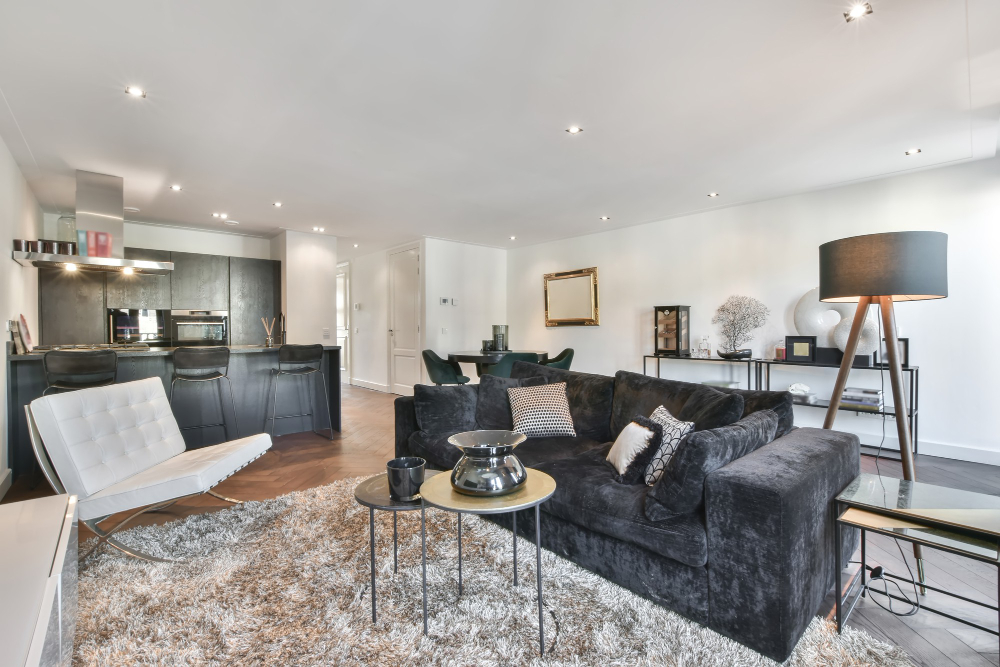Last updated on
The living room couch, more than just a seating option, stands as the linchpin of home aesthetics, dictating the ambiance, style, and functionality of the space it occupies.
This cornerstone piece of furniture can uniquely elevate a room’s design, act as a bold statement piece, and mirror the homeowner’s style and sensibilities.
This article delves into the profound impact of couch design on home aesthetics, shedding light on the importance of texture, color, and form, offering insights into selecting the perfect couch that strikes a harmonious balance between comfort and aesthetic appeal.
The Impact of Texture, Color, and Form

Texture’s Transformative Touch
The texture of a couch directly influences the ambiance of a room. Soft, inviting fabrics like microfiber or wool can make a space feel more cozy and welcoming, perfect for a family room or casual living space.
In contrast, high-end materials like leather or velvet add a layer of sophistication and elegance, suitable for formal settings or luxury homes. The choice of texture should align with the room’s intended use and desired atmosphere, contributing to the overall aesthetic and comfort level.
Color’s Commanding Presence
The color of a couch can anchor the room’s aesthetic and influence mood and emotions. Neutral tones like beige, gray, or navy offer a canvas for accent colors and personal expression through throw pillows and accessories.
Bright or unconventional colors can turn the couch into a bold statement piece, adding vibrancy and energy to the space. The selection process involves balancing the couch’s visual impact with the room’s palette and design goals.
Form’s Fundamental Influence
The shape and structure of a couch determine how it interacts with the space. Modern, minimalist designs with clean lines and slim profiles suit contemporary spaces, enhancing the sense of openness and simplicity.
Traditional styles with rounded edges, ornate details, and plush cushions lend a sense of warmth and comfort, suitable for classic or eclectic interiors. The couch’s form should complement the room’s architectural features and align with the homeowner’s functional needs and style preferences.
Selecting the Perfect Couch: Comfort Meets Aesthetic Appeal

Choosing the right couch involves more than just picking a style or color; it’s about finding a piece that embodies comfort and design excellence. This balance is crucial for creating an inviting and visually appealing living space.
- Ergonomics and Comfort
The ergonomic design of a couch is essential for supporting proper posture and ensuring comfort during use. Features you should consider include the height of the backrest, the seat depth, and the cushions’ firmness. These elements should cater to the physical needs of the users while also fitting into the aesthetic framework of the room.
- Size and Scale Considerations
The dimensions of the couch should be proportionate to the room’s size and the scale of other furnishings. A well-chosen couch complements the space without overwhelming it, maintaining harmony and balance within the design scheme.
- Stylistic Alignment
The couch’s design should reflect the overall theme and aesthetic of the room. Whether aiming for a sleek, modern look or a cozy, traditional feel, the couch should serve as a cohesive element that ties the space together.
Navigating these considerations can be complex, highlighting the value of professional guidance. For those seeking to seamlessly integrate comfort and style in their living spaces, turning to experts in interior design couches can offer a wealth of options and insights, ensuring the selected couch not only meets functional needs but also enhances the room’s aesthetics.
Iconic Couch Designs: Timeless Focal Points in Interior Design
Iconic couch designs can define a room’s aesthetic and become a source of inspiration for the entire home. These pieces, celebrated for their innovative design, craftsmanship, and impact on trends, serve as focal points in interior design, transcending their functional role as seating.
- The Chesterfield Sofa
This classic design, known for its quilted or tufted upholstery and rich history, brings elegance and stature to any room. Its distinctive look makes it a favorite for those seeking to add a touch of traditional luxury to modern homes.
- The Mid-Century Modern Sofa
Characterized by clean lines, organic shapes, and functional elegance, mid-century modern couches are versatile and timeless. They blend well with various interior styles, from retro to contemporary, embodying the design ethos of the mid-20th century.
- The Sectional Sofa
Offering flexibility in configuration and size, you can count on sectional sofas to cater to modern living needs, making them ideal for family rooms and informal gathering spaces. Their modular design allows customization to fit any room layout, providing both style and practicality.
Integrating Couches into Diverse Interior Themes
The versatility of modern couch designs allows them to be seamlessly integrated into a wide range of interior themes, from minimalist and contemporary to traditional and eclectic. The key to successful integration lies in understanding the design principles underpinning each style and selecting a couch that effectively complements or contrasts these principles.
Minimalist Interiors
In minimalist interiors, the couch often serves as the room’s focal point. A minimalist couch design emphasizes clean lines, simplicity, and functionality, focusing on space-saving and clutter-reducing features.
Contemporary Spaces
Contemporary interior themes favor innovation and trends, often incorporating bold colors, unique forms, and cutting-edge materials. A contemporary couch might feature unconventional shapes or materials, serving as a statement piece that reflects the homeowner’s modern sensibility.
Traditional and Eclectic Environments
Traditional and eclectic interiors allow for more ornate and diverse couch designs, incorporating rich fabrics, intricate details, and classic forms. In these settings, the couch often complements the room’s historical elements or eclectic mix of styles, adding to the layered and curated look of the space.
The Takeaway: The Couch as a Reflection of Personal & Cultural Trends
The modern couch stands at the intersection of comfort, aesthetics, and functionality, reflecting broader trends in interior design, lifestyle, and technology. As we continue to seek furniture that looks good and meets our diverse needs, the couch will undoubtedly remain a central feature of home interiors, adapting and evolving along with us.
Whether through the integration of smart technology, the emphasis on sustainability, or the shift towards customizable design, the future of couch design promises to continue its trajectory of innovation, ensuring that this staple piece of furniture remains as relevant and cherished as ever in our homes.
Table of Contents




